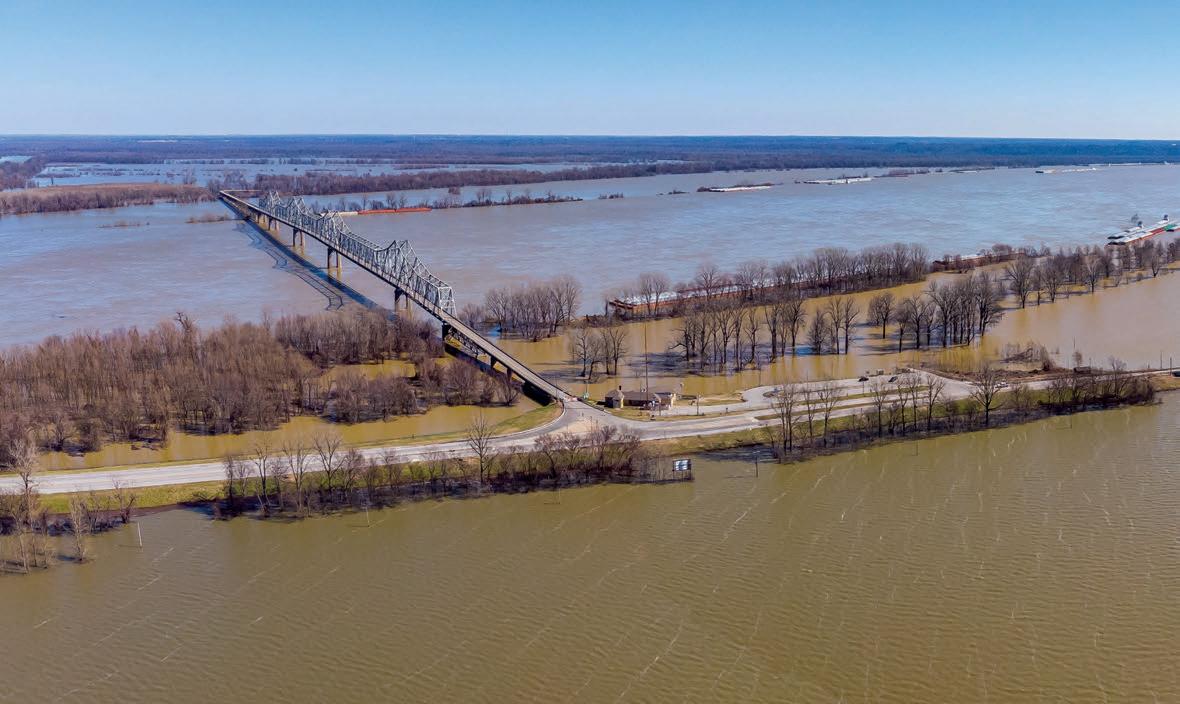
When the flooding ends and the river recedes back to its channel, it leaves behind silt on the floodplain. Silt is a fine dirt that holds water. The cycle of flooding, depositing silt, and receding waters makes the soil around rivers particularly good for growing things.
But as people began living permanently in the low-lying plains around the Mississippi, flooding on the river became destructive. When the Mississippi floods today, millions of people are affected. And because the river's drainage system covers more than 40 percent of the United States, wet weather in one section of the country can cause serious floods many miles away.
For example, in December 1926, snowstorms blanketed Montana, South Dakota, and Minnesota. Then in March 1927, blizzards buried Wyoming, Colorado, and Nebraska and parts of Texas, Oklahoma, and Missouri. Farther south, it rained. That spring, melting snow fed into nearby rivers, which overflowed their banks. Most of that water eventually reached the Mississippi.
By the time the Mississippi River rolled through Arkansas, Mississippi, and Louisiana that year, it was so swollen that the levees crumbled under the immense weight of the water. The river spilled into the farmlands and towns of the Mississippi River Delta. It filled 27,000 square miles, the size of four New England states. More than 600,000 people lost their homes. An estimated 500 people lost their lives. It was the biggest flood on record to hit the Lower Mississippi.
この記事は Cobblestone American History Magazine for Kids の April 2023 版に掲載されています。
7 日間の Magzter GOLD 無料トライアルを開始して、何千もの厳選されたプレミアム ストーリー、9,000 以上の雑誌や新聞にアクセスしてください。
すでに購読者です ? サインイン
この記事は Cobblestone American History Magazine for Kids の April 2023 版に掲載されています。
7 日間の Magzter GOLD 無料トライアルを開始して、何千もの厳選されたプレミアム ストーリー、9,000 以上の雑誌や新聞にアクセスしてください。
すでに購読者です? サインイン

Eye in the Sky
An interview with Joe Piotrowski

Airborne Animals
Humans have taken to the skies in balloons, gliders, and airplanes-but we're not alone among the clouds. Animals of all sorts have evolved to harness wind power.

TAKING OFF
The Wright brothers expected airplanes to “take off,” but even they might be amazed at the way the airline industry has become big business. In the past, it was expensive to send something by plane.

GROWTH OF AN INDUSTRY
After their historic flight at Kitty Hawk in 1903, Wilbur and Orville Wright returned to Dayton, Ohio. They spent the next few years making adjustments and building additional versions of their powered aircraft in their bicycle shop.

WHY KITTY HAWK?
The Wright brothers searched carefully for the best place to test their gliders and flying machines. Their main concern was for good, steady winds. But they also hoped to find a remote location to allow them to perform tests away from the public eye.

Two Brothers From Ohio
Most people do not realize that the Wright brothers—Wilbur, born in 1867, and Orville, born in 1871—performed various scientific experiments before inventing their aircraft. For as long as anyone in their hometown of Dayton, Ohio, could remember, the Wright boys had worked on mechanical projects.

A Helping Hand
May 6, 1896. A group of people who had gathered beside the Potomac River, just south of the U.S. capital, grew quiet. Then, it erupted in cheers as a small, unmanned aircraft took to the skies and flew for more than half a mile. The flight came seven years before the Wright brothers’ first manned, powered flight. The inventor of the aircraft was Dr. Samuel Pierpont Langley.

THE IDEA MEN
People dreamed of flying thousands of years before the Wright brothers found success near Kitty Hawk, North Carolina. These dreamers, such as Leonardo da Vinci, studied birds flying and imagined how humans might do the same—if only they had wings. Other men developed a more hands-on approach to the topic. Early inventors made wings of cloth, glue, and feathers and tied these creations to their arms in an attempt to imitate nature.

Da Vinci's 4 Designs
Have you ever wondered how a bird flies? Leonardo da Vinci (1452–1519) did. He thought that understanding how a bird flies would provide the key to human flight. So, what did da Vinci learn from birds?

Silken Wings
Seven hundred years before the Wright brothers began experimenting with human flight, the Chinese had already mastered its secrets—with kites.